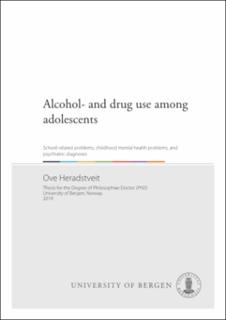| dc.description.abstract | Background Adolescents with alcohol and drug-related problems (ADP) are at heightened risk for a range of difficulties, such as mental health problems and school-related problems. However, the nature of the association between ADP and mental health problems is complex and many questions remain unanswered. More knowledge is also needed on how ADP is related to school-problems such as poor grade achievement and absence from school, and how mental health problems affect these associations. Furthermore, previous findings are inconsistent on how mental health problems during childhood, particularly internalizing problems, are associated with ADP during adolescence. Finally, although previous research have demonstrated that adolescents with psychiatric diagnoses have higher rates of ADP compared to the general population, there is a lack of knowledge regarding which of these psychiatric diagnoses that are more strongly associated with ADP during adolescence, particularly when psychiatric comorbidity is accounted for. Objectives The main objective of this thesis is to investigate alcohol/drug use and its association with mental health and school-related factors among adolescents. More specifically, the objectives are to examine (a) the cross-sectional associations between ADP and school-related problems among adolescents, (b) the longitudinal associations between childhood externalizing and internalizing mental health problems and ADP during adolescence, and (c) which psychiatric diagnoses that precede the development of ADP among adolescents receiving specialist mental health care. Methods All papers included adolescents aged 16 to 19 years of age who had participated in the youth@hordaland survey (n=10,253), which provided self-reported data on demographics, mental health problems, and alcohol/drug use. First, utilizing data from the youth@hordaland survey in linkage with official school registry data on school grades and attendance, including a total of 7,874 individuals, the cross-sectional associations between ADP and school-related problems were investigated. Second, data from the first, second and fourth wave of the Bergen Child Study (BCS) was employed (the fourth wave was nested within the youth@hordaland survey) including a total of 2,438 individuals, and longitudinal associations between childhood externalizing/internalizing problems and ADP were analyzed. Third, data from the youth@hordaland survey was linked with the Norwegian Patient Registry (NPR), including a total of 9,408 individuals, of whom 853 had received specialist mental health care during the past four years. Psychiatric diagnoses that preceded adolescent ADP were investigated. All studies included logistic regression analyses. Results ADP during adolescence was consistently associated with school-related problems in cross-sectional analyses. More specifically, alcohol/drug use was associated with low grade point average (GPA), high number of days missed from school, and high number of hours missed from school (Odds ratios (ORs) ranging from 1.79 to 3.44, all p<0.001). Adjusting for gender, age, socioeconomic status and co-occurring mental health problems reduced the magnitude of the estimates; however, all associations remained statistically significant. In longitudinal analyses, childhood externalizing problems were positively associated with ADP during adolescence, particularly after the adjustment from cooccurring internalizing problems, SES, gender and age (Adjusted odds ratios (AORs) ranging from 1.24 to 1.40, all p<0.05). In contrast, internalizing problems during childhood was consistently negatively associated with adolescent ADP after the adjustment from co-occurring externalizing problems, SES, gender and age (AORs ranging from 0.83 to 0.87, all p<0.05). In analyses conducted on the merged data set of the youth@hordaland survey and the Norwegian Patient Registry (NPR), higher odds for ADP were observed among adolescents that had received specialist mental health care during the past four years compared to adolescents from the general population (p’s ranging from <0.001 to <0.05). In unadjusted models, anxiety, depression, conduct disorders, eating disorders, ADHD, and trauma- and stressor-related disorders were all positively associated with some measure of ADP (ORs ranging from 1.60 to 4.76, all p<0.05). However, anxiety and ADHD were no longer positively associated with any measure of ADP after adjusting for age, gender, SES, and psychiatric comorbidity. While trauma-related disorders, depression and conduct disorders were positively associated with increasing levels of indicators for ADP in unadjusted analyses (ORs ranging from 1.92 to 3.20, all p<0.05), only trauma-related disorders remained positively associated when adjusted for age, gender, SES, and psychiatric comorbidity (AOR 2.53, p<0.01). Conclusion ADP was consistently positively associated with school-related problems, clearly suggesting that alcohol/drug use among adolescents are important factors for school-related functioning. Externalizing problems during childhood showed for the most part robust and consistent positive associations with ADP during adolescence, while childhood internalizing problems was negatively associated with ADP when potential confounding variables were accounted for. The occurrence of ADP was more common among adolescents who had received specialist mental health care, and among adolescents receiving specialist mental health care, individuals with trauma-related disorders had a particularly high-risk for developing ADP. In sum, efforts aiming at improving school functioning among adolescents should be aware of the importance of reducing alcohol/drug use; early prevention initiatives to reduce future alcohol/drug involvement should target children with externalizing problems; and specialist mental health care practitioners should address issues related to adolescent alcohol/drug use, particularly among individuals with trauma-related disorders. | en_US |
| dc.relation.haspart | Paper II: Heradstveit, O., Skogen, J. C., Bøe, T., Hetland, J., Pedersen, M. U., & Hysing, M. (2018). Prospective associations between childhood externalising and internalising problems and adolescent alcohol and drug use: The Bergen Child Study. Nordic Studies on Alcohol and Drugs, 1455072518789852. The article is available at: <a href="http://hdl.handle.net/1956/19592" target="blank">http://hdl.handle.net/1956/19592</a> | eng |
